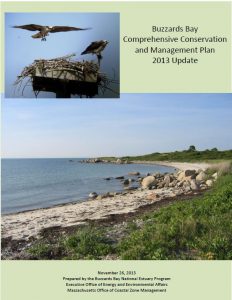2013 CCMP, Action Plan 21:
Enhancing Public Education and Participation
About the new Buzzards Bay CCMP Action Plans
The Buzzards Bay Comprehensive Conservation and Management Plan (CCMP) was updated in November 2013 to reflect the great progress achieved since the original CCMP was finalized. You can download the entire document (buzzards-bay-ccmp-2013-update.pdf) or just this action plan Enhancing Public Education and Participation Action Plan.
Enhancing Public Education and Participation
Problem
Government can be slow to address environmental problems because of work force or financial constraints, political pressures, concerns of potential economic im-pacts, or failure of legislative and executive bodies to revise or adopt new laws and regulations. In a democra-cy, the response of government to any problem is strongly driven by the public’s concerns and understanding of the issues. While it is true that given the same set of facts, persons can disagree about the proper course of actions depending on individual priorities and values, a common vocabulary in defining problems can facilitate the development of consensus among disparate parties. If the public is ill informed on a particular environmental problem, or if it does not have a clear understanding of important technical and regulatory issues, they may fail to appreciate the costs and benefits of management actions, or inaction. Contributing to the problem, people, first as children, then as adults, may not have been educated about concepts like groundwater flow, pollution pathways in local watersheds, how wastewater is treated and disposed, or the connection between ground and surface waters.
Because many of the recommendations in the Buzzards Bay CCMP are directed toward local government, and may require voter approval or approval by town meeting or local boards, it is particularly important to have an informed citizenry to help make these decisions. Citizen groups and environmental non-governmental organizations can provide a crucial role in educating adults and children that will ultimately lead to the necessary social, political, regulatory, legislative, and legal actions to support efforts to protect and restore Buzzards Bay and surrounding watershed. The contribution of these non-governmental partners will be most important when legislative bodies and governmental boards must make specific planning, regulatory, and budgetary decisions.
Many action plans in this document include elements of outreach and education. This action plan addresses some statewide and regional issues that should be addressed to meet the broader goals of the Buzzards Bay CCMP.
Goals
Goal 21.1. To expand the public’s knowledge of the natural resources and water quality of Buzzards Bay and surrounding watershed and the threats they face.
Goal 21.2. To increase public participation in actions that support the goals, objectives, and recommendations in the Buzzards Bay CCMP.
Objectives
Objective 21.1. To better convey concepts of watersheds and the flow of water from precipitation along the land surface and in the ground.
Objective 21.2. To better convey an understanding of pollution sources and pathways in the environment.
Objective 21.3. To improve the public understanding of human and natural effects on plant and animal populations and ecosystems.
Approaches
The Massachusetts education curriculum needs to convey more effectively a basic understanding of local watersheds and the pathways of water and pollution through ground and surface waters. To address this problem, the University of Massachusetts developed a primary school teacher education program called “Our Town, Our City” to help teachers adopt local curriculum that incorporates local history and environmental information into their school programs, including showing local watershed maps. This approach should be emulated throughout the Buzzards Bay watershed and local school districts could teach essential concepts about water and pollution flow through watersheds as part of earth science curricula.
Advocacy and education by leaders and citizen groups will remain a core strategy to promote the adop-tion of regulatory and non-regulatory actions by local, state, and federal government. Both private groups and public agencies should better utilize alternate strategies for communicating information including videos on local cable access channels and the internet, and social media.
Costs and Financing
Annual public education costs can be appreciable or negligible, depending on the approach and type of campaign. Schools, government agencies, and non-governmental agencies must prioritize outreach programs based on their resources. Potential funding includes various, state, federal, and private sources de-pending upon initiative.
Measuring Success
There is no simple way to determine if education efforts are successful. One potential method of quantifying the success is to periodically conduct baseline public opinion surveys of attitudes and knowledge. This is a long-term, generational, and unending task.
